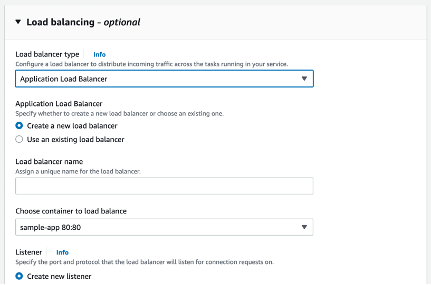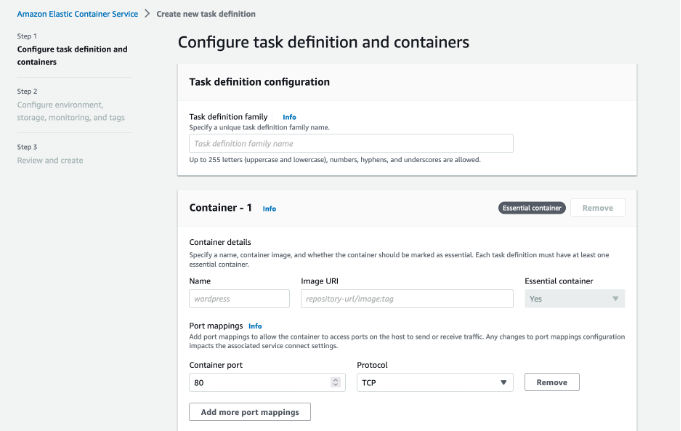Containers
Announcing upcoming changes to the Amazon ECS console
Today, we’re excited to announce that the new Amazon Elastic Container Service (Amazon ECS) console becomes the default starting January 2023. The new console makes it easier to deploy containerized applications, configure load balancing, networking, monitoring, and gives you the new workflows for the effective operations and troubleshooting. Since its launch at re:Invent 2014, Amazon ECS focused on helping you easily deploy, run, and scale containerized applications on AWS. Amazon ECS has evolved over the years to become a fully managed container orchestration service that deeply integrates with a number of AWS services to provide a secure and easy-to-use solution for running container workloads on AWS. As of October 2022, more than 2 billion workloads have been launched on Amazon ECS every week, making it one of the largest container orchestration services in the world. Combined with the serverless control plane and serverless compute of AWS Fargate, Amazon ECS gives developers the speed, security, and agility to build applications and grow their businesses. Customers such as Vanguard, Capital One, Expedia, and NerdWallet trust Amazon ECS to run their mission-critical applications.
The new Amazon ECS console makes it easier to deploy tasks and services, configure load balancing, networking, and monitoring, and gives you workflows for effective operations and troubleshooting. The new console was launched as a public preview on December 30, 2020. We rapidly iterated to support existing and new Amazon ECS features and to address your feedback. We’re excited for the new console to become the default experience and we understand that some users need time to adapt to this change. Consequently, the classic console will remain available to opt-in, so you can learn and migrate to the new console at your own pace. You’ll be able to toggle back to the classic console for the duration of your login session.
We want to highlight some features of the new Amazon ECS console:
A guided deployment experience

We designed the new Amazon ECS console to have simpler and more efficient workflows, which provide intuitive defaults and enable users to finish their task with fewer clicks, inputs, and less switches to other pages. A common request from our customers was to simplify service creation workflow. In the new Amazon ECS console, users can now create a new load balancer or select an existing load balancer, when they create a new service:

You can specify few parameters (e.g., new load balancer name, listener with port parameters, and a container to receive the traffic). The console provisions a new load balancer and configures based on the required target groups and listeners to load balance traffic for the new service.
Another significant change is a new design for the creation of task definitions workflow. The task definition resource is the one of the most feature-rich Amazon ECS resources. We strive to maintain a balance between simple and advanced use cases. We want to ensure you can quickly create task definitions in the console and access all required advanced features when needed. The new task definition creation workflow is a multi-step wizard. In the first step, you can specify all containers and their basic properties:

In the second step, you can configure parameters of the compute environment, storage, monitoring, and logging for your tasks.

If you need to use all capabilities of Task Definitions, you can use Create new task definition with JSON or Create revision with JSON features to modify properties that are not available within the console:

This feature is the first step we are taking to bring additional advanced functionality to the Amazon ECS console. We recognize that the new task definition wizard is not a “one size fits all” solution and are looking forward for your feedback on which features should become the part of the new wizard.

Powered by AWS CloudFormation
Infrastructure as code tools, like AWS CloudFormation, AWS Cloud Development Kit (AWS CDK), and Terraform by HashiCorp, enable developers to use automation, test, and deliver applications rapidly at scale. The new Amazon ECS console uses AWS CloudFormation to provision resources when you submit the forms. When you create a cluster, a task definition, or a service, the new console generates an AWS CloudFormation template to provision AWS CloudFormation stacks, which is a collection of AWS resources that you create within the console.

Now you can use the AWS CloudFormation stacks that Amazon ECS console created for you, to track changes or drifts to the stack, rollback or cleanup resources, and even download the AWS CloudFormation template to store them in your code repository for a continuous integration and delivery (CI/CD) automation:

With this, we’ve created the foundation for further improvements and features that will make using infrastructure as code simpler for Amazon ECS users.
Accessibility, dark mode, and more
We continue to make sure that the console is accessible. In the new console, we adopted the new AWS Console design system, which focuses even more on the accessibility and an improved user interface. Dark mode is one of the most requested features by developers. Dark mode helps reduce eye strain and provides contrast in bright environments, which improves readability and accessibility. Dark mode also improves the navigation across user interfaces and reduces energy consumption on some devices.
In Unified Settings, you can choose between three settings for visual mode (i.e., browser default, dark, and light). The browser default applies the default dark or light setting of the browser. Dark applies the new built-in dark mode, and light maintains the current look and feel of the AWS Console. You can select dark mode in Unified Settings by logging into the AWS Console, selecting the account menu, and selecting Settings.

The new console will become the default starting January 2023. We’re taking an iterative approach to add new features based on customers’ feedback. While we work to bring parity between the two consoles, both will exist in parallel. If you rely on one of the few features that have not yet transitioned to the new console, then please continue to use the previous console experience and send us feedback with what features are missing. Starting 2023, you can toggle back to the classic console similar to how you opt-in to the new console today.
For more information Amazon ECS, please look at the following resources: